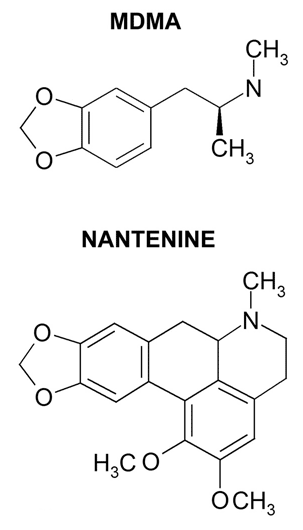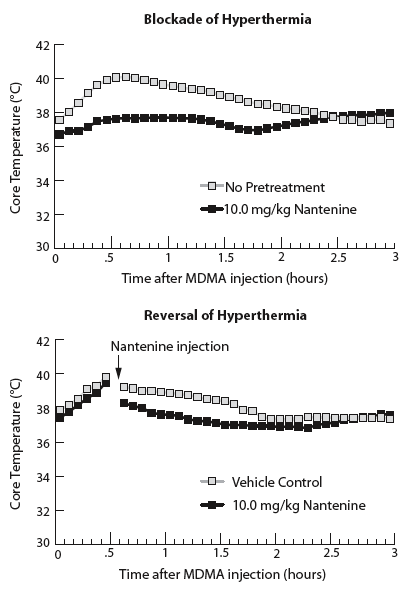
The club drug MDMA ("Ecstasy") suppresses the 's temperature-regulating system, occasionally with fatal consequences. Abusers have developed temperatures as high as 109°F, suffered multiple organ failure, and died. Treatment in these emergencies has been limited mainly to cooling the victim with ice or refrigerating blankets. Now, NIDA-supported research suggests that nantenine, a compound derived from the berries of a plant used in Asian traditional medicine (Nandina domestica, or heavenly bamboo), may be able to block and reverse hyperthermia and other effects of MDMA.
Dr. William Fantegrossi began investigating nantenine's properties after seeing a diagram of its chemical structure presented by Dr. Yasushi Ohizumi of Tohoku University in Sendai, Japan. "The compound's chemical structure suggested that it might have neurobiological activity," Dr. Fantegrossi says. "It looks like two MDMA molecules joined at the hip." Dr. Fantegrossi speculated that nantenine, like MDMA, might bind in the brain to serotonin and α1-adrenergic receptors. If so, nantenine could block MDMA from occupying those sites and causing destructive changes.
To test this possibility, Dr. Fantegrossi and colleagues at the University of Michigan in Ann Arbor injected mice with nantenine and MDMA. In a first study, nantenine pretreatment protected mice from developing a hyperthermic response when they were subsequently injected with MDMA. "The complete attenuation of hyperthermia following pretreatment with nantenine was interesting," Dr. Fantegrossi observes, "but a far more useful clinical effect would be reversal of hyperthermia previously induced by MDMA." To test for this effect, the scientists injected mice with MDMA, and 30 minutes later, when the mice were hyperthermic, injected half of them with nantenine. Body temperatures of the mice receiving nantenine rapidly returned to baseline, while the other mice remained hyperthermic for close to 3 hours.
 Nantenine Blocks and Reverses MDMA's Hyperthermic Effect
Nantenine Blocks and Reverses MDMA's Hyperthermic EffectFurther tests confirmed nantenine's ability to block some of MDMA's other effects. In one group of mice, pretreatment with nantenine reduced MDMA-induced motor activity: One hour after injection with MDMA, untreated mice were three times as active as mice pretreated with nantenine. In another part of the study, researchers injected mice pretreated with nantenine with a lethal dose of MDMA; the nantenine reduced mortality by 50 percent. Research now under way, says Dr. Fantegrossi, suggests nantenine has similar anti-MDMA effects in monkeys.
"If nantenine has effects in humans similar to those we've seen in mice, it will be an enormous benefit," Dr. Fantegrossi says. "In emergency rooms today, doctors have no medication much more sophisticated than ice to treat patients for the hyperthermia sometimes triggered by MDMA." The compound also has important potential as a tool for use in other research projects, observes Dr. Jerry Frankenheim of NIDA's Division of Basic Neuroscience and Behavioral Research. "There are few MDMA-specific research tools that we can use to investigate the mechanisms of MDMA action in the ," he says. "At least in animals, this molecule looks very promising."
Source
- Fantegrossi, W.E., et al. Nantenine: An antagonist of the behavioral and physiological effects of MDMA in mice. Psychopharmacology 173(3-4):270-277, 2004.
